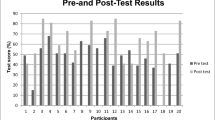Abstract
There is currently no structured system for nurses or allied health professionals to undertake further training to become a nurse specialist (NSp) or nurse practitioner (NP) in rheumatology on-site, while working in a district general hospital setting. These shortcomings have prompted us to develop a structured pathway that could be followed by staff nurses who wish to become NSp in rheumatology. The proposed pathway aims to assist the nurses or therapists (physiotherapists, psychologists, occupational therapist, podiatrists, etc.) to develop a sound knowledge based on the rationale, safety, and high quality clinical care when monitoring of patients taking disease-modifying anti-rheumatic drugs (DMARDs) to ensure they acquire skills enabling them to provide safe, evidence-based effective patient-centered care. Near the end of the pathway, the trainee would be expected to have an understanding of the particularities of chronic arthritis conditions as well as screening, assessment, and monitoring of patients receiving DMARDs and biological agents. Tests for competencies are included and certification may be considered.
Similar content being viewed by others
References
Bird H (1983) Divided rheumatology care: the advent of the nurse practitioner? Ann Rheum Dis 42:354–355
Hill J, Bird H, Lawton C et al (1994) An evaluation of the effectiveness, safety and acceptability of a nurse practitioner in a rheumatology outpatient clinic. Br J Rheumatol 33:283–288
Hill J (1985) Nursing clinics for arthritis. Nurs Times 81:33–34
Hill J (1992) A nurse practitioner rheumatology clinic. Nurs Stand 7:35–37
Symmons DP, Bankhead CR, Griffiths I et al (1996) Changing patterns of rheumatology manpower and practice in the UK in the 1990s. Br J Rheumatol 35:483–488
Hale C, Hill J (2006) Locating the evidence base for musculoskeletal nursing: an overview of the rheumatology nursing literature. Int J Nurs Stud 43:507–518
Hanly JG (2001) Canadian council of academic rheumatologists. Manpower in Canadian academic rheumatology units: current status and future trends. J Rheumatol 28:1944–1951
Moya F, Rusinol M, Comulada J et al (1999) Nurse led rheumatology clinic in a department of rheumatology. Revista Espanola de Rheumatologia 26:304–309
Rheumatology nursing in Eular (2010) HP news 1:10
Pincus T, Gibofsky A, Weinblatt ME (2002) Urgent care and tight control of rheumatoid arthritis as in diabetes and hypertension: better treatments but a shortage of rheumatologists [editorial]. Arthr Rheum 46:851–854
van den Hout WB, Tijhuis GJ, Hazes JM et al (2003) Cost effectiveness and cost utility analysis of multidisciplinary care in patients with rheumatoid arthritis: randomized comparison of clinical nurse specialist care, in-patients team care and day patient team care. Ann Rheum Dis 62:308–315
Stucki G (2003) Economic analysis rheumatoid arthritis, clinical nurse specialist, multidisciplinary team: understanding disability. Ann Rheum Dis 62:289–290
Nursing, midwifery council (2004) Standards of proficiency for pre-registration nursing education. Nursing and midwifery Council, London
Almeida C, Clarke B, O’Brien A et al (2006) Current provision of rheumatology education for undergraduate nursing occupational therapy and physiotherapy students in the UK. Rheumatology (Oxford) 45:868–873
Happel B, Rushworth L (2003) Can educational methods influence the popularity of psychiatric nursing? Nurs Edu Today 20:318–326
Hewlett S, Clarke B, O’Brien A et al (2008) Rheumatology education for undergraduate nursing, physiotherapy and occupational therapy students in the UK: standards, challenges and solutions. Rheumatology 47:1025–1031
Grahame R, West J (1996) The role of the rheumatology nurse practitioner in primary care: an experiment in the further education of the practice nurse. Br J Rheumatol 35: 581–588
Cornelissen PG, Rasker JJ, Valkenburg HA (1998) The arthritis sufferer and the community: a comparison of arthritis sufferers in rural and urban areas. Ann Rheum Dis 47:150–156
Royal College of Nursing Report (2001) Standards for effective practice and audit in rheumatology nursing. London
Li LC, Backman C, Bombardier C, Hammond A et al (2004) Focusing on care research: a challenge and an opportunity. Arthr Rheum (Arthr Care Res) 51(6):874–876
Bird HA, Wright V, Galloway D (1980) Clinical metrology—a future career grade? Lancet 2:138–140
McCabe C, McDowell J, Cushnaghan J et al (2000) Rheumatology telephone helplines: an activity analysis. Rheumatology 39:1390–1395
Davis P (2003) The application of telehealth to rheumatology. Clin Rheumatol 22:168–172
Lewis CE, Resnick BA (1967) Nurse clinics and progressive ampulatory care. N Eng J Med 277:1236–1241
Hill J, Bird HA, Hopkins R et al (1992) Survey of satisfaction with care in a rheumatology out-patient clinic. Ann Rheum Dis 51:195–197
Hill J (1997) Patient satisfaction in a nurse-led rheumatology clinic. J Adv Nurs 25:347–354
Hill J, Oliver S, Finney D (2010) The demographics, educational attainment and current practices of rheumatology nurses and allied health professionals in the UK. Rheumatolgy (Oxford) 49:1599–1600
Centers for Disease Control, Prevention (2003) Public health and ageing: projected prevalence of self reported arthritis or chronic joints symptoms among persons aged 65 years. United states, 2005–2030. MMWR Morb Mortal Wkly Rep 52:489–491
The Bone and Joint Decade. The Bone and Joint Decade 2001–2010.http://www.boneandjointdecade.org
Kanz JN, Barrett J, Liang MH et al (1998) Utilization of rheumatology physician services by the elderly. Am J Med 105:312–318
Acknowledgments
Drs. Nehad Ibrahim, Laura Congi, Coziana Ciurtin, Judit Bartko, Kifayat Malik, Shahzabeen Sultana are acknowledged for providing information about the existence of nurse specialists position in Rheumatology in Spain, Italy, Romania, Hungary, Pakistan, Bangladesh.
Conflict of interest
None.
Author information
Authors and Affiliations
Corresponding author
Additional information
Caroline Iacovou: Deceased.
Rights and permissions
About this article
Cite this article
Roussou, E., Iacovou, C. & Georgiou, L. Development of a structured on-site nursing program for training nurse specialists in rheumatology. Rheumatol Int 32, 1685–1690 (2012). https://doi.org/10.1007/s00296-011-1869-z
Received:
Accepted:
Published:
Issue Date:
DOI: https://doi.org/10.1007/s00296-011-1869-z




